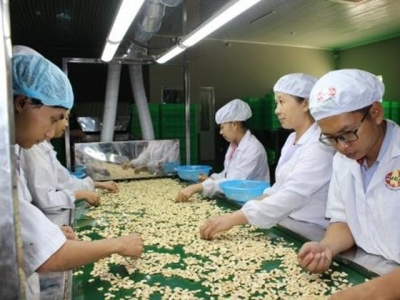Cashew nut exports increase, but processors face shortage of raw materials

A cashew processing factory in Bình Phước Province. — VNA/VNS Photo
Ho Chi Minh City — Việt Nam exported 141,000 tonnes of cashew nuts for a value of U$$1.39 billion in the first five months of the year, a year-on-year increase of 21.4 per cent and 25.3 per cent, respectively, according to the Việt Nam Cashew Association.
With this result, Việt Nam retains its position as the world’s largest cashew processor and exporter for the 13th consecutive year, accounting for 65 per cent of the world’s total cashew export revenue, according to Đặng Hoàng Giang, the association’s chairman.
Despite having positive export growth, cashew farmers and processing firms enjoyed only 30-35 per cent of profit in the value chain, with the remainder in the hands of international cashew processors and traders, according to Nguyễn Đức Thanh, Vinacas’s chairman.
Currently, domestic processors are facing difficulties due to lack of raw materials.
Speaking at a meeting in HCM City on Friday, Giang said the volume of raw material imports had been very low in recent months. As a result, many cashew processing firms had to suspend operations.
In Long An Province, only 12 out of 33 cashew processing firms were operating, he said, adding that 80 per cent of cashew processors, mostly small and micro enterprises, in Bình Phước Province had also suspended operations.
Tạ Quang Huyên, who is also deputy chairman of Vinacas and director of Hoàng Sơn 1 Company in Bình Phước Province, said in the first five months of 2018, Vietnamese firms imported 283,000 tonnes of raw cashews plus 370,000 tonnes from domestic supply and purchases from Cambodia via border trade, totaling 653,000 tonnes.
With the ratio of 4.3 kilos of raw cashew materials offering one kilo of cashew kernels, and 141,000 tonnes of cashew kernels exported in the first five months of the year, all of the 653,000 tonnes of raw materials were processed in the first five months.
"This means that enterprises have no inventory or very limited inventory, so they have to wait for raw materials," he said.
Huyên said Vietnamese firms this year increased processing capacity by 25 per cent over the same period last year, providing the market with a large volume of cashew products. Thus, foreign traders had been able to force them to sell at lower prices.
Cashew prices had fallen this year to $8.2 per kilo from $11 per kilo last year, so processing firms had broken even or taken a loss.
"Cashew nuts can be stored for a year, but because most local processing firms are small scale and have limited financial capacity, they have to sell their products soon after production,” he said.
"Cashew output globally is estimated to increase by 4 per cent this year, while demand for cashew products is expected to increase by 5 per cent. With limited inventory, cashew prices will recover in the coming time,” he added.
Trần Văn Hiệp, head of the trade promotion board at Vinacas, said cashew prices were expected to increase again.
Companies had strong potential, prestigious brands and quality products, and would be able to overcome this difficult period and continue to develop, he said.
Golden Cashew Rendezvous
At the meeting, Vinacas announced that the 10th Vinacas Golden Cashew Rendezvous would be held from October 5 to 7 in Hạ Long Bay to promote trade and expand markets for cashew products.
Co-organised by the Việt Nam Cashew Association (Vinacas) and Việt Nam Trade Promotion Agency, the largest event in Việt Nam’s cashew sector is expected to attract about 500 domestic and international delegates from 50 countries and territories.
Có thể bạn quan tâm
 Is market and quality the “trump-card” in the agriculture sector?
Is market and quality the “trump-card” in the agriculture sector? Vietnam's agricultural products are present in about 180 markets around the world with many top export items. In order to make the agriculture sector grow
 Quang Tri draws investment in hi-tech agriculture
Quang Tri draws investment in hi-tech agriculture The central province of Quang Tri has drawn several investment projects in hi-tech and organic agriculture recently
 Seminar discusses post-harvest technology for mangos
Seminar discusses post-harvest technology for mangos A seminar on post-harvest technology for mangos took place in Cao Lanh city, the Mekong Delta province of Dong Thap on June 19.